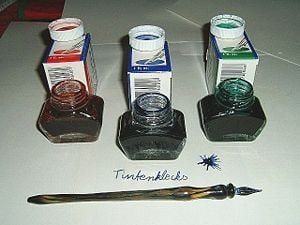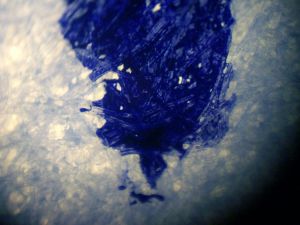Ink
- For other uses, see Ink (disambiguation).
An ink is a liquid containing various pigments and/or dyes used for colouring a surface to render an image or text. Ink is used for drawing or writing with a pen or brush. Thicker inks, in a paste form, are used extensively in letterpress and lithographic printing.
Types of ink
Early varieties of ink include Egyptian ink, various natural dyes made from metals, the husk or outer covering of nuts or seeds, and sea creatures like the squid (known as sepia ). India ink is black and originated in Asia. Walnut ink and iron-gall nut ink were made and used by many of the early masters to obtain the golden brown ink used for drawing.
Pigmented inks
Pigmented inks contain other agents that ensure adhesion of the pigment to the surface and prevent it from being removed by mechanical abrasion. These materials are typically referred to as resins (in solvent-based inks) or binding agents (in water-based inks).
Pigmented inks are advantageous when printing on paper because the pigment stays on the surface of the paper. This is desirable because more ink on the surface of the paper means less ink needs to be used to create the same intensity of color.
Pigments are the main components of ink, containing the different colors. The size of the pigment is very important for the ability of diffuse in the solution inks. Qualities such as hue, saturation, and brightness are inherent in the ink, varying dependent on the source and type of pigment.
Dyes in inks
Dyes, however, are generally much stronger and can produce more color of a given density per unit of mass. However, because dyes are dissolved in the liquid phase, they have a tendency to soak into paper, thus making the ink less efficient and also potentially allowing for the ink to bleed at the edges, producing poor quality printing.
To circumvent this problem, dye-based inks are made with solvents that dry rapidly or are used with quick-drying methods of printing, such as blowing hot air on the fresh print. Other methods to resolve this include harder paper sizing and more specialized paper coatings. The latter is particularly suited to inks that are used in non-industrial settings (and thus must conform to tighter toxicity and emission controls), such as inkjet printer inks, include coating the paper with a charged coating. If the dye has the opposite charge, then it is attracted to and retained by this coating, while the solvent soaks into the paper. Cellulose, the material that paper is made of, is also naturally charged, and so a compound that complexes with both the dye and the paper surface aids retention at the surface. Such a compound in common use in ink-jet printing inks is polyvinyl pyrrolidone.
An additional advantage of dye-based ink systems is that the dye molecules interact chemically with other ink ingredients. This means that they can benefit more than pigmented ink from optical brighteners and colour-enhancing agents designed to increase the intensity and appearance of dyes. Because dyes get their colour from the interaction of electrons in their molecules, the way in which the electrons can move is determined by the charge and extent of electron delocalisation in the other ink ingredients. The colour emerges as a function of the light energy that falls on the dye. Thus, if an optical brightener or colour enhancer absorbs light energy and emits it through or with the dye, the appearance changes, as the spectrum of light re-emitted to the observer changes.
A disadvantage of dye-based inks is that they can be more susceptible to fading, especially when exposed to ultraviolet radiation as in sunlight.
History of ink
Approximately 5000 years ago, the Chinese developed ink for blackening the raised surfaces of pictures and texts carved in stone. This early ink was a mixture of soot from pine smoke, lamp oil, and gelatin from animal skins and musk. Other early cultures also developed inks (of many colors) from available berries, plants and minerals.
In an article for the Christian Science Monitor, Sharon J. Huntington describes these other historical inks:
About 1,600 years ago, a popular ink recipe was created. The recipe was used for centuries. Iron "salts," such as ferrous sulfate (made by treating iron with sulfuric acid), was mixed with tannin from gallnuts (they grow on trees) and a thickener. When first put to paper, this ink is bluish-black. Over time it fades to a dull brown.
Scribes in medieval Europe (about AD 800 to 1500) wrote on sheepskin parchment. One 12th century ink recipe called for hawthorn branches to be cut in the spring and left to dry. Then the bark was pounded from the branches and soaked in water for eight days. The water was boiled until it thickened and turned black. Wine was added during boiling. The ink was poured into special bags and hung in the sun. Once dried, the mixture was mixed with wine and iron salt over a fire to make the final ink.
In the 14th century, a new type of ink had to be developed in Europe for the printing press by Johannes Gutenberg. Two types of ink were prevalent at the time: the Greek and Roman writing ink (soot, glue, and water) and the 12th century variety composed of ferrous sulfate, nutgall, gum, and water. Neither of these handwriting inks could adhere to printing surfaces without creating blurs. Eventually an oily, varnish-like ink made of soot, turpentine, and walnut oil was created specifically for the printing press.Ink is made from plants
Modern Ink Applications
Up to a few years ago, consumers had very little interest in ink other than to buy refills for their pens. Fountain pens became a novelty as the disposable ball point pen took over the market. The introduction of home computing lead to home printing. Today it is rare to find a residence or a business that does not have a printing capability. As a result, buying "ink" in the form of a cartridge or having that cartridge refilled at an inkjet island in a local mall has once again become a part of the day to day shopping experience in a similar way that buying a bottle of ink was common 50 years ago.
Ink refilling services for printer cartridges are offered by large, official printing companies as well as smaller, "unofficial" refill companies. Customers can often cut printing costs by using refill services from a refill company.
ReferencesISBN links support NWE through referral fees
- "Think Ink!" by Sharon J. Huntington, Christian Science Monitor, September 21, 2004, retrieved January 17, 2006.
- "A History of Technology and Invention" by Maurice Audin, page 630
See also
- Dokumental
- Invisible ink
- Soy ink
- Quink
- Ink sac
- Stark's Ink
External links
- Detailed online textbook on inks, antiquity-1904
- Extensive List of Ink Recipes
- Tips on removing ink stains from clothing
cs:Tuž da:Blæk de:Tinte eo:Inko es:Tinta fi:Muste fr:Encre he:דיו it:Inchiostro ja:インク nl:Inkt nn:blekk no:blekk simple:Ink sv:bläck zh:墨


